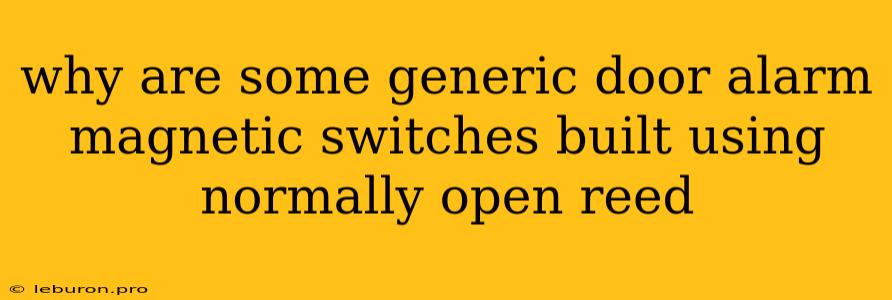Why Are Some Generic Door Alarm Magnetic Switches Built Using Normally Open Reed?
Home security systems, particularly DIY alarm systems, often utilize magnetic switches, also known as door/window contacts, to detect unauthorized entry. These switches typically consist of two parts: a magnet and a reed switch. The reed switch, a small, sealed glass tube containing a pair of ferromagnetic reeds, is triggered when the magnet comes within a specific proximity, completing the circuit. While both normally open and normally closed reed switches can be used in security systems, there's a clear preference for normally open reed switches in generic door alarm systems. This article will delve into the reasons behind this choice, exploring the advantages and disadvantages of each type of switch.
Understanding Normally Open and Normally Closed Reed Switches
Normally Open (NO) Reed Switches:
These switches are in an open circuit state when the magnet is not present. The magnetic field created by the magnet brings the reeds together, closing the circuit.
Normally Closed (NC) Reed Switches:
In contrast, NC reed switches are in a closed circuit state when the magnet is not present. The magnet's magnetic field causes the reeds to separate, opening the circuit.
Why Normally Open Reed Switches are Favored in Generic Door Alarm Systems
The choice of NO reed switches in generic door alarm systems is driven by a combination of factors, including:
1. Simplicity and Cost Effectiveness:
Using NO reed switches simplifies the design and wiring of the alarm system. The system is in a passive state when the door or window is closed (magnet present), and only activates when the magnet is removed, indicating an open door or window. This inherently simple design eliminates the need for additional circuitry to monitor the state of the switch, making it cheaper to manufacture.
2. Power Consumption:
NO reed switches only consume power when the alarm is triggered. This is a crucial factor in battery-powered alarm systems, as it extends the battery life considerably.
3. Open Circuit Protection:
In the event of a wire break or short circuit, NO reed switches will trigger the alarm, alerting the user to a potential problem. This provides an additional layer of security and ensures that the system remains functional even with compromised wiring.
4. Ease of Installation:
NO reed switches are generally easier to install than NC reed switches, particularly in DIY settings. This is because the wiring connections are simpler, and the user doesn't need to consider the state of the switch during installation.
Disadvantages of Using Normally Open Reed Switches
While NO reed switches offer numerous advantages, they also have certain drawbacks:
1. False Positives:
Strong magnetic fields from external sources, such as passing vehicles or nearby magnets, can trigger NO reed switches, leading to false alarms. This issue is less common in professionally installed systems, where shielding and proper placement mitigate the risk of interference.
2. Limited Sensitivity:
NO reed switches can be less sensitive than NC reed switches, requiring a closer proximity between the magnet and the reed switch for activation. This might result in false readings if the magnet is slightly offset or if the door/window is not completely shut.
3. Susceptibility to Tampering:
NO reed switches can be vulnerable to tampering by cutting the wires or disabling the magnet. This is particularly relevant in cases where the alarm system is not professionally monitored.
Conclusion
While both normally open and normally closed reed switches have their own benefits and drawbacks, NO reed switches are the preferred choice for generic door alarm systems due to their simplicity, cost effectiveness, and ease of installation. However, it's important to note that NO reed switches are susceptible to false positives and tampering, so it's essential to consider these factors when selecting and installing a door alarm system. Ultimately, the choice of switch type depends on the specific requirements and security needs of the user.
